Environmental Sustainability and the Oil Industry
VerifiedAdded on 2019/12/28
|11
|2574
|161
Report
AI Summary
The provided content discusses the challenges and concerns surrounding the extraction and production of natural gas through hydraulic fracturing (fracking). The articles highlight issues related to water management, wastewater treatment, and potential contamination of drinking water. Additionally, the online resources examine the impact of oil prices on major oil companies' dividends, cash flow, and the industry's transition towards a low-carbon future.
Contribute Materials
Your contribution can guide someone’s learning journey. Share your
documents today.
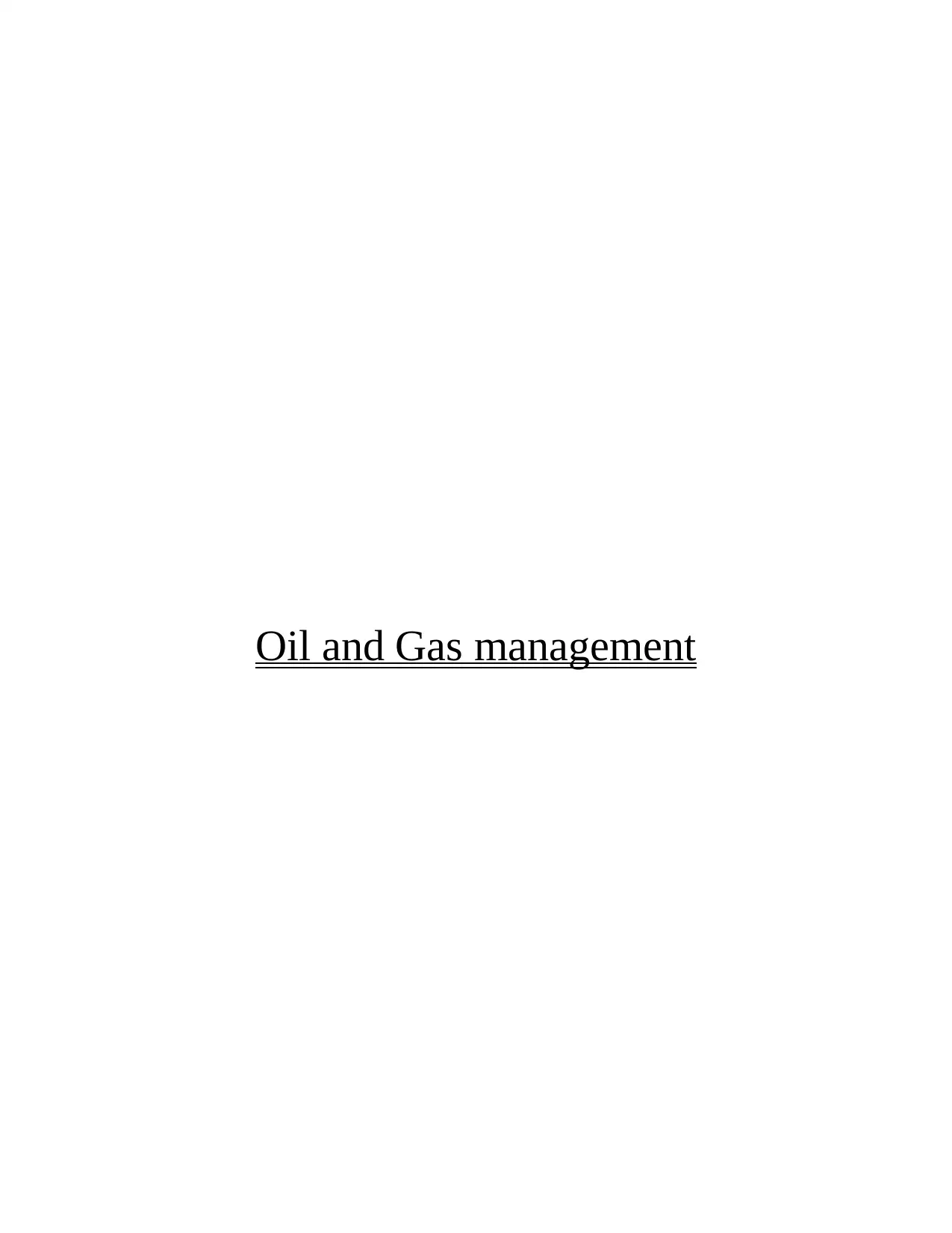
Oil and Gas management
Secure Best Marks with AI Grader
Need help grading? Try our AI Grader for instant feedback on your assignments.

TABLE OF CONTENTS
INTRODUCTION...........................................................................................................................3
CONCLUSION................................................................................................................................7
REFERENCES................................................................................................................................8
2
INTRODUCTION...........................................................................................................................3
CONCLUSION................................................................................................................................7
REFERENCES................................................................................................................................8
2

Illustration Index
Illustration 1: Deficit spending of big oil.........................................................................................5
Illustration 2: Low carbon emission in big oil.................................................................................7
3
Illustration 1: Deficit spending of big oil.........................................................................................5
Illustration 2: Low carbon emission in big oil.................................................................................7
3
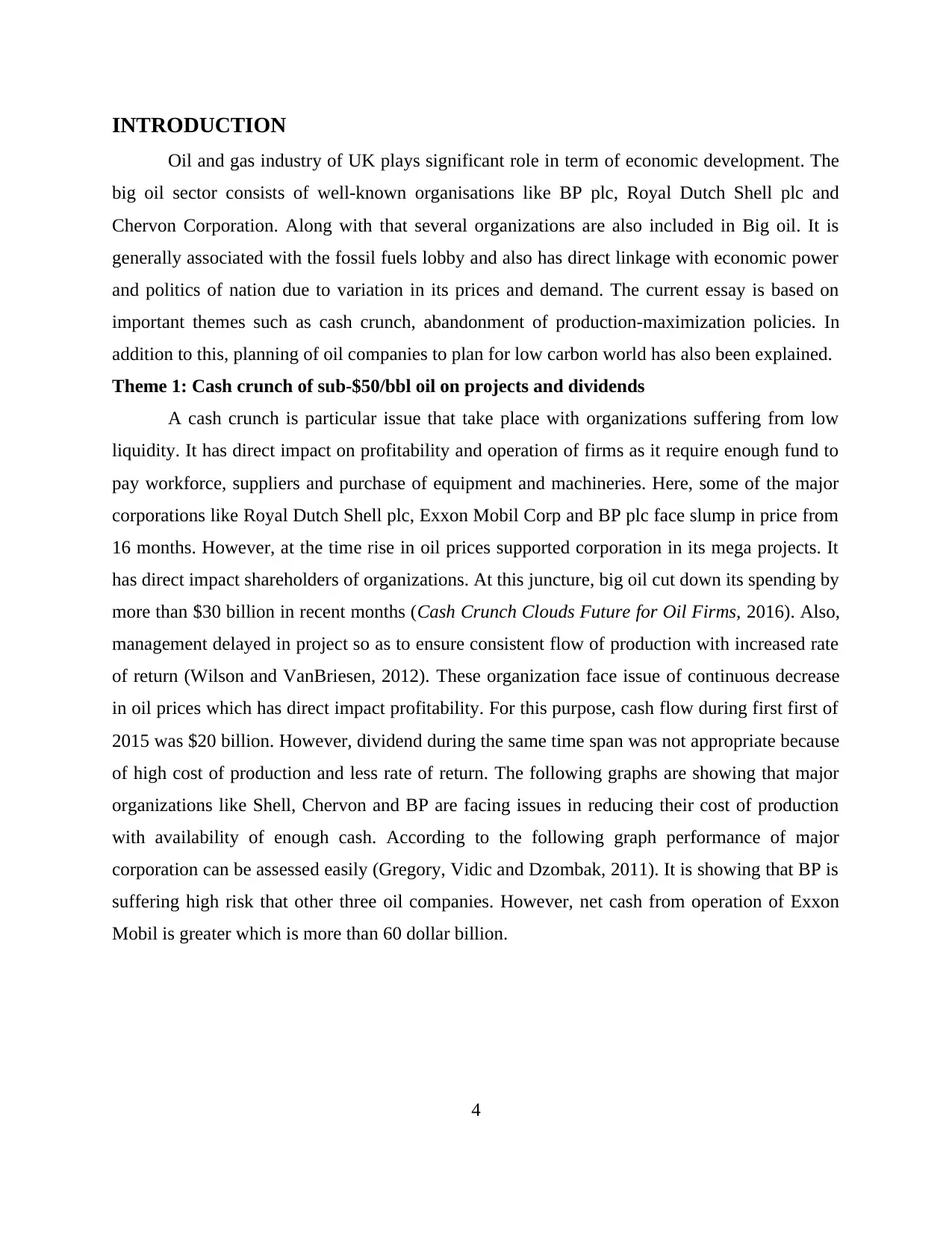
INTRODUCTION
Oil and gas industry of UK plays significant role in term of economic development. The
big oil sector consists of well-known organisations like BP plc, Royal Dutch Shell plc and
Chervon Corporation. Along with that several organizations are also included in Big oil. It is
generally associated with the fossil fuels lobby and also has direct linkage with economic power
and politics of nation due to variation in its prices and demand. The current essay is based on
important themes such as cash crunch, abandonment of production-maximization policies. In
addition to this, planning of oil companies to plan for low carbon world has also been explained.
Theme 1: Cash crunch of sub-$50/bbl oil on projects and dividends
A cash crunch is particular issue that take place with organizations suffering from low
liquidity. It has direct impact on profitability and operation of firms as it require enough fund to
pay workforce, suppliers and purchase of equipment and machineries. Here, some of the major
corporations like Royal Dutch Shell plc, Exxon Mobil Corp and BP plc face slump in price from
16 months. However, at the time rise in oil prices supported corporation in its mega projects. It
has direct impact shareholders of organizations. At this juncture, big oil cut down its spending by
more than $30 billion in recent months (Cash Crunch Clouds Future for Oil Firms, 2016). Also,
management delayed in project so as to ensure consistent flow of production with increased rate
of return (Wilson and VanBriesen, 2012). These organization face issue of continuous decrease
in oil prices which has direct impact profitability. For this purpose, cash flow during first first of
2015 was $20 billion. However, dividend during the same time span was not appropriate because
of high cost of production and less rate of return. The following graphs are showing that major
organizations like Shell, Chervon and BP are facing issues in reducing their cost of production
with availability of enough cash. According to the following graph performance of major
corporation can be assessed easily (Gregory, Vidic and Dzombak, 2011). It is showing that BP is
suffering high risk that other three oil companies. However, net cash from operation of Exxon
Mobil is greater which is more than 60 dollar billion.
4
Oil and gas industry of UK plays significant role in term of economic development. The
big oil sector consists of well-known organisations like BP plc, Royal Dutch Shell plc and
Chervon Corporation. Along with that several organizations are also included in Big oil. It is
generally associated with the fossil fuels lobby and also has direct linkage with economic power
and politics of nation due to variation in its prices and demand. The current essay is based on
important themes such as cash crunch, abandonment of production-maximization policies. In
addition to this, planning of oil companies to plan for low carbon world has also been explained.
Theme 1: Cash crunch of sub-$50/bbl oil on projects and dividends
A cash crunch is particular issue that take place with organizations suffering from low
liquidity. It has direct impact on profitability and operation of firms as it require enough fund to
pay workforce, suppliers and purchase of equipment and machineries. Here, some of the major
corporations like Royal Dutch Shell plc, Exxon Mobil Corp and BP plc face slump in price from
16 months. However, at the time rise in oil prices supported corporation in its mega projects. It
has direct impact shareholders of organizations. At this juncture, big oil cut down its spending by
more than $30 billion in recent months (Cash Crunch Clouds Future for Oil Firms, 2016). Also,
management delayed in project so as to ensure consistent flow of production with increased rate
of return (Wilson and VanBriesen, 2012). These organization face issue of continuous decrease
in oil prices which has direct impact profitability. For this purpose, cash flow during first first of
2015 was $20 billion. However, dividend during the same time span was not appropriate because
of high cost of production and less rate of return. The following graphs are showing that major
organizations like Shell, Chervon and BP are facing issues in reducing their cost of production
with availability of enough cash. According to the following graph performance of major
corporation can be assessed easily (Gregory, Vidic and Dzombak, 2011). It is showing that BP is
suffering high risk that other three oil companies. However, net cash from operation of Exxon
Mobil is greater which is more than 60 dollar billion.
4
Secure Best Marks with AI Grader
Need help grading? Try our AI Grader for instant feedback on your assignments.
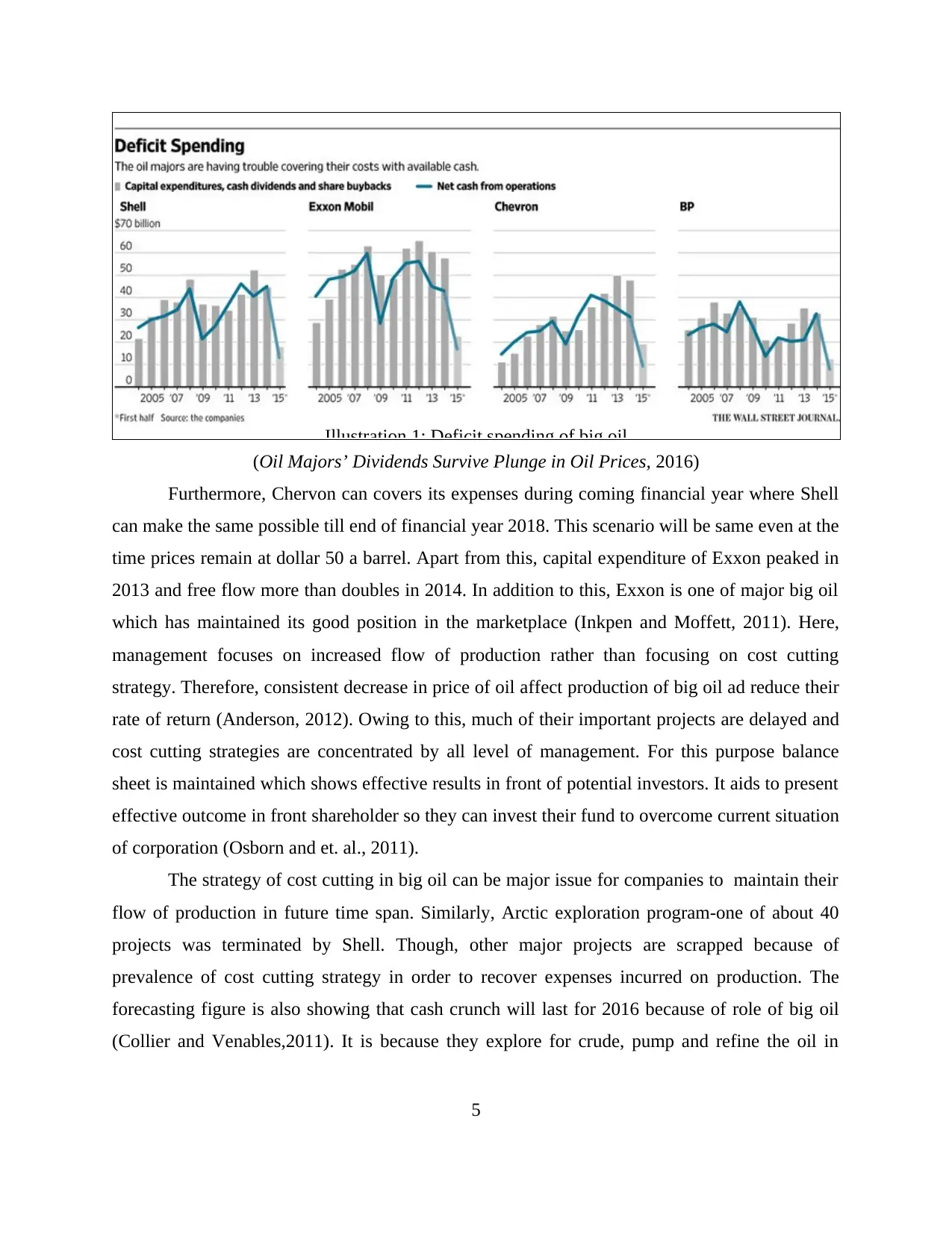
(Oil Majors’ Dividends Survive Plunge in Oil Prices, 2016)
Furthermore, Chervon can covers its expenses during coming financial year where Shell
can make the same possible till end of financial year 2018. This scenario will be same even at the
time prices remain at dollar 50 a barrel. Apart from this, capital expenditure of Exxon peaked in
2013 and free flow more than doubles in 2014. In addition to this, Exxon is one of major big oil
which has maintained its good position in the marketplace (Inkpen and Moffett, 2011). Here,
management focuses on increased flow of production rather than focusing on cost cutting
strategy. Therefore, consistent decrease in price of oil affect production of big oil ad reduce their
rate of return (Anderson, 2012). Owing to this, much of their important projects are delayed and
cost cutting strategies are concentrated by all level of management. For this purpose balance
sheet is maintained which shows effective results in front of potential investors. It aids to present
effective outcome in front shareholder so they can invest their fund to overcome current situation
of corporation (Osborn and et. al., 2011).
The strategy of cost cutting in big oil can be major issue for companies to maintain their
flow of production in future time span. Similarly, Arctic exploration program-one of about 40
projects was terminated by Shell. Though, other major projects are scrapped because of
prevalence of cost cutting strategy in order to recover expenses incurred on production. The
forecasting figure is also showing that cash crunch will last for 2016 because of role of big oil
(Collier and Venables,2011). It is because they explore for crude, pump and refine the oil in
5
Illustration 1: Deficit spending of big oil
Furthermore, Chervon can covers its expenses during coming financial year where Shell
can make the same possible till end of financial year 2018. This scenario will be same even at the
time prices remain at dollar 50 a barrel. Apart from this, capital expenditure of Exxon peaked in
2013 and free flow more than doubles in 2014. In addition to this, Exxon is one of major big oil
which has maintained its good position in the marketplace (Inkpen and Moffett, 2011). Here,
management focuses on increased flow of production rather than focusing on cost cutting
strategy. Therefore, consistent decrease in price of oil affect production of big oil ad reduce their
rate of return (Anderson, 2012). Owing to this, much of their important projects are delayed and
cost cutting strategies are concentrated by all level of management. For this purpose balance
sheet is maintained which shows effective results in front of potential investors. It aids to present
effective outcome in front shareholder so they can invest their fund to overcome current situation
of corporation (Osborn and et. al., 2011).
The strategy of cost cutting in big oil can be major issue for companies to maintain their
flow of production in future time span. Similarly, Arctic exploration program-one of about 40
projects was terminated by Shell. Though, other major projects are scrapped because of
prevalence of cost cutting strategy in order to recover expenses incurred on production. The
forecasting figure is also showing that cash crunch will last for 2016 because of role of big oil
(Collier and Venables,2011). It is because they explore for crude, pump and refine the oil in
5
Illustration 1: Deficit spending of big oil
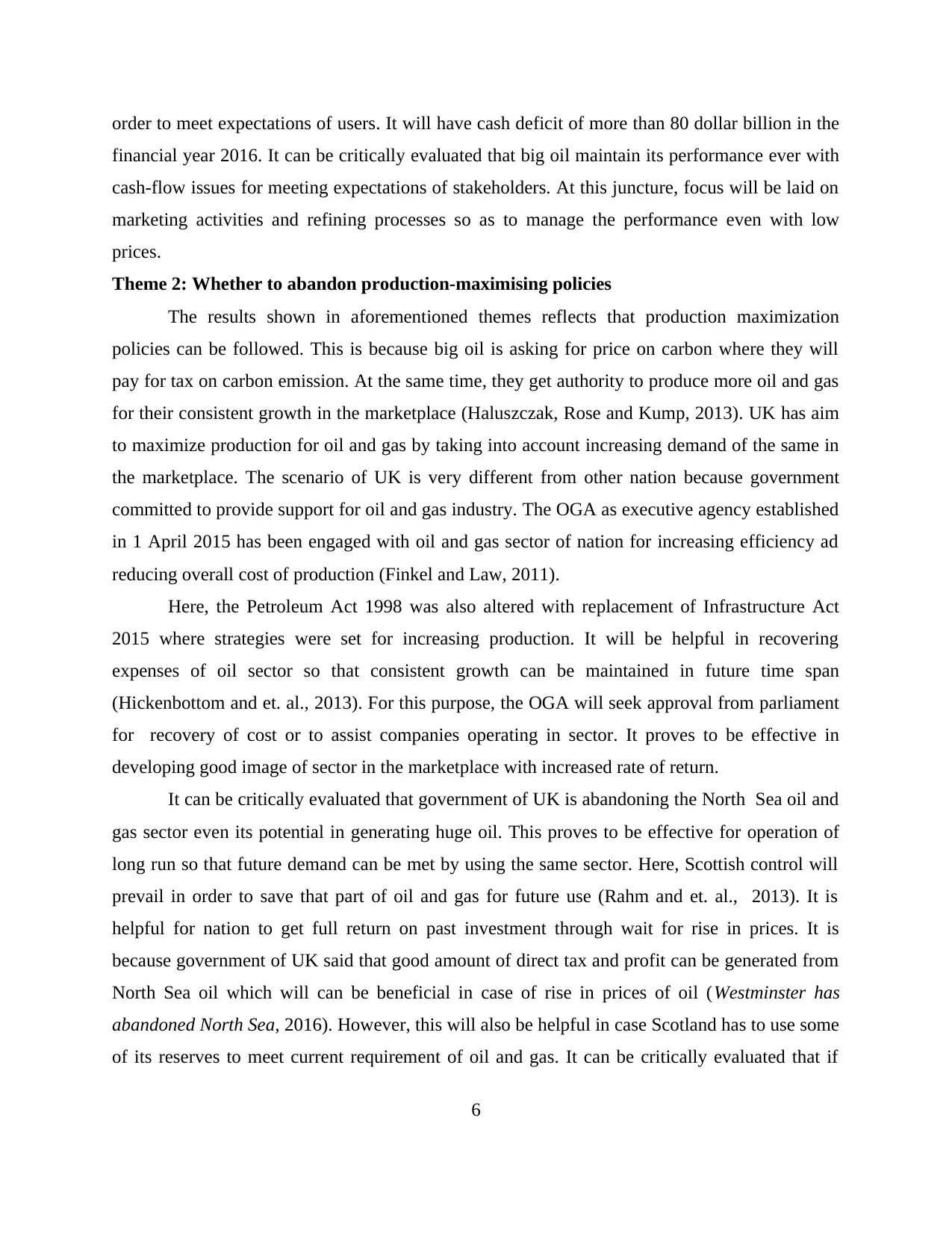
order to meet expectations of users. It will have cash deficit of more than 80 dollar billion in the
financial year 2016. It can be critically evaluated that big oil maintain its performance ever with
cash-flow issues for meeting expectations of stakeholders. At this juncture, focus will be laid on
marketing activities and refining processes so as to manage the performance even with low
prices.
Theme 2: Whether to abandon production-maximising policies
The results shown in aforementioned themes reflects that production maximization
policies can be followed. This is because big oil is asking for price on carbon where they will
pay for tax on carbon emission. At the same time, they get authority to produce more oil and gas
for their consistent growth in the marketplace (Haluszczak, Rose and Kump, 2013). UK has aim
to maximize production for oil and gas by taking into account increasing demand of the same in
the marketplace. The scenario of UK is very different from other nation because government
committed to provide support for oil and gas industry. The OGA as executive agency established
in 1 April 2015 has been engaged with oil and gas sector of nation for increasing efficiency ad
reducing overall cost of production (Finkel and Law, 2011).
Here, the Petroleum Act 1998 was also altered with replacement of Infrastructure Act
2015 where strategies were set for increasing production. It will be helpful in recovering
expenses of oil sector so that consistent growth can be maintained in future time span
(Hickenbottom and et. al., 2013). For this purpose, the OGA will seek approval from parliament
for recovery of cost or to assist companies operating in sector. It proves to be effective in
developing good image of sector in the marketplace with increased rate of return.
It can be critically evaluated that government of UK is abandoning the North Sea oil and
gas sector even its potential in generating huge oil. This proves to be effective for operation of
long run so that future demand can be met by using the same sector. Here, Scottish control will
prevail in order to save that part of oil and gas for future use (Rahm and et. al., 2013). It is
helpful for nation to get full return on past investment through wait for rise in prices. It is
because government of UK said that good amount of direct tax and profit can be generated from
North Sea oil which will can be beneficial in case of rise in prices of oil (Westminster has
abandoned North Sea, 2016). However, this will also be helpful in case Scotland has to use some
of its reserves to meet current requirement of oil and gas. It can be critically evaluated that if
6
financial year 2016. It can be critically evaluated that big oil maintain its performance ever with
cash-flow issues for meeting expectations of stakeholders. At this juncture, focus will be laid on
marketing activities and refining processes so as to manage the performance even with low
prices.
Theme 2: Whether to abandon production-maximising policies
The results shown in aforementioned themes reflects that production maximization
policies can be followed. This is because big oil is asking for price on carbon where they will
pay for tax on carbon emission. At the same time, they get authority to produce more oil and gas
for their consistent growth in the marketplace (Haluszczak, Rose and Kump, 2013). UK has aim
to maximize production for oil and gas by taking into account increasing demand of the same in
the marketplace. The scenario of UK is very different from other nation because government
committed to provide support for oil and gas industry. The OGA as executive agency established
in 1 April 2015 has been engaged with oil and gas sector of nation for increasing efficiency ad
reducing overall cost of production (Finkel and Law, 2011).
Here, the Petroleum Act 1998 was also altered with replacement of Infrastructure Act
2015 where strategies were set for increasing production. It will be helpful in recovering
expenses of oil sector so that consistent growth can be maintained in future time span
(Hickenbottom and et. al., 2013). For this purpose, the OGA will seek approval from parliament
for recovery of cost or to assist companies operating in sector. It proves to be effective in
developing good image of sector in the marketplace with increased rate of return.
It can be critically evaluated that government of UK is abandoning the North Sea oil and
gas sector even its potential in generating huge oil. This proves to be effective for operation of
long run so that future demand can be met by using the same sector. Here, Scottish control will
prevail in order to save that part of oil and gas for future use (Rahm and et. al., 2013). It is
helpful for nation to get full return on past investment through wait for rise in prices. It is
because government of UK said that good amount of direct tax and profit can be generated from
North Sea oil which will can be beneficial in case of rise in prices of oil (Westminster has
abandoned North Sea, 2016). However, this will also be helpful in case Scotland has to use some
of its reserves to meet current requirement of oil and gas. It can be critically evaluated that if
6
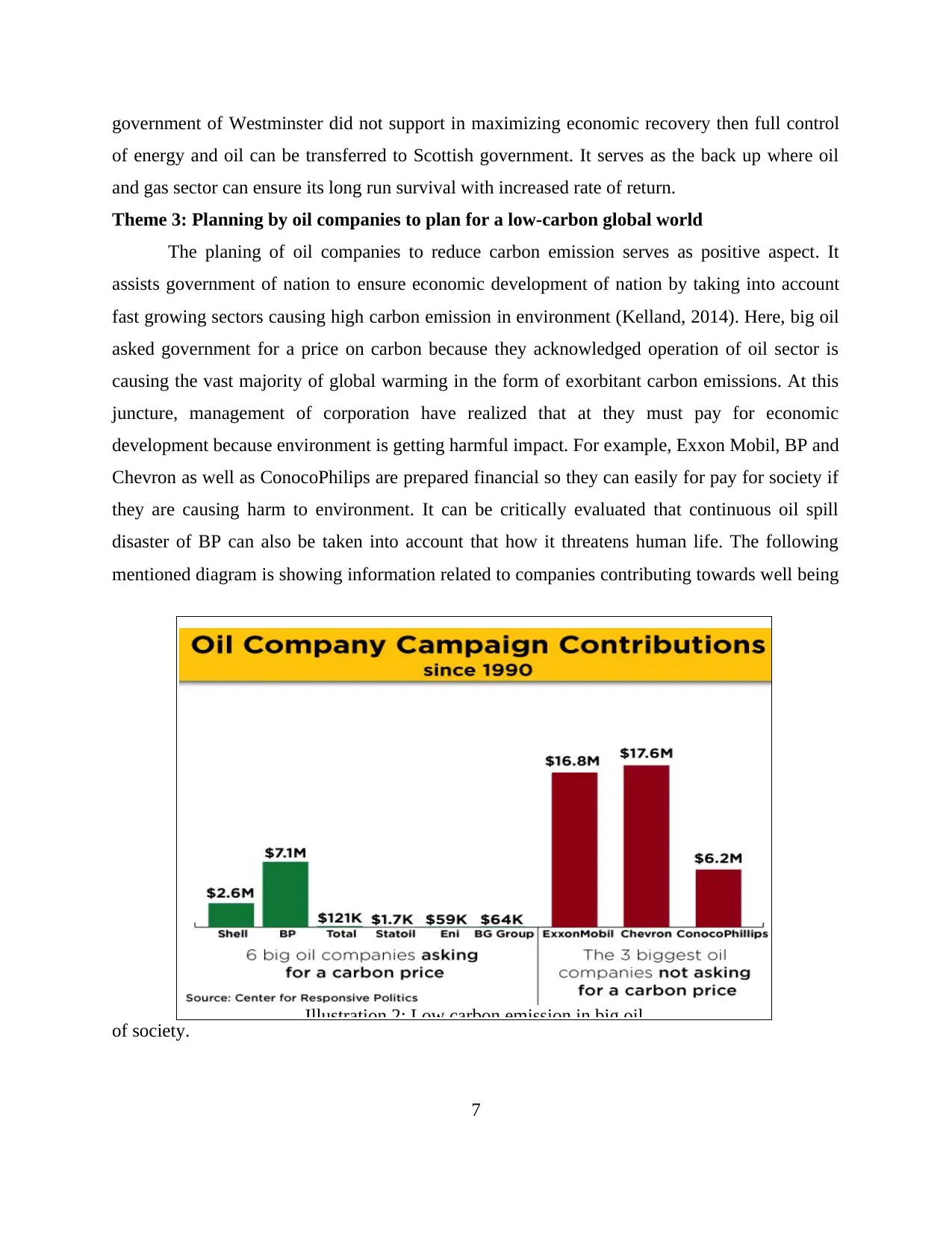
government of Westminster did not support in maximizing economic recovery then full control
of energy and oil can be transferred to Scottish government. It serves as the back up where oil
and gas sector can ensure its long run survival with increased rate of return.
Theme 3: Planning by oil companies to plan for a low-carbon global world
The planing of oil companies to reduce carbon emission serves as positive aspect. It
assists government of nation to ensure economic development of nation by taking into account
fast growing sectors causing high carbon emission in environment (Kelland, 2014). Here, big oil
asked government for a price on carbon because they acknowledged operation of oil sector is
causing the vast majority of global warming in the form of exorbitant carbon emissions. At this
juncture, management of corporation have realized that at they must pay for economic
development because environment is getting harmful impact. For example, Exxon Mobil, BP and
Chevron as well as ConocoPhilips are prepared financial so they can easily for pay for society if
they are causing harm to environment. It can be critically evaluated that continuous oil spill
disaster of BP can also be taken into account that how it threatens human life. The following
mentioned diagram is showing information related to companies contributing towards well being
of society.
7
Illustration 2: Low carbon emission in big oil
of energy and oil can be transferred to Scottish government. It serves as the back up where oil
and gas sector can ensure its long run survival with increased rate of return.
Theme 3: Planning by oil companies to plan for a low-carbon global world
The planing of oil companies to reduce carbon emission serves as positive aspect. It
assists government of nation to ensure economic development of nation by taking into account
fast growing sectors causing high carbon emission in environment (Kelland, 2014). Here, big oil
asked government for a price on carbon because they acknowledged operation of oil sector is
causing the vast majority of global warming in the form of exorbitant carbon emissions. At this
juncture, management of corporation have realized that at they must pay for economic
development because environment is getting harmful impact. For example, Exxon Mobil, BP and
Chevron as well as ConocoPhilips are prepared financial so they can easily for pay for society if
they are causing harm to environment. It can be critically evaluated that continuous oil spill
disaster of BP can also be taken into account that how it threatens human life. The following
mentioned diagram is showing information related to companies contributing towards well being
of society.
7
Illustration 2: Low carbon emission in big oil
Paraphrase This Document
Need a fresh take? Get an instant paraphrase of this document with our AI Paraphraser
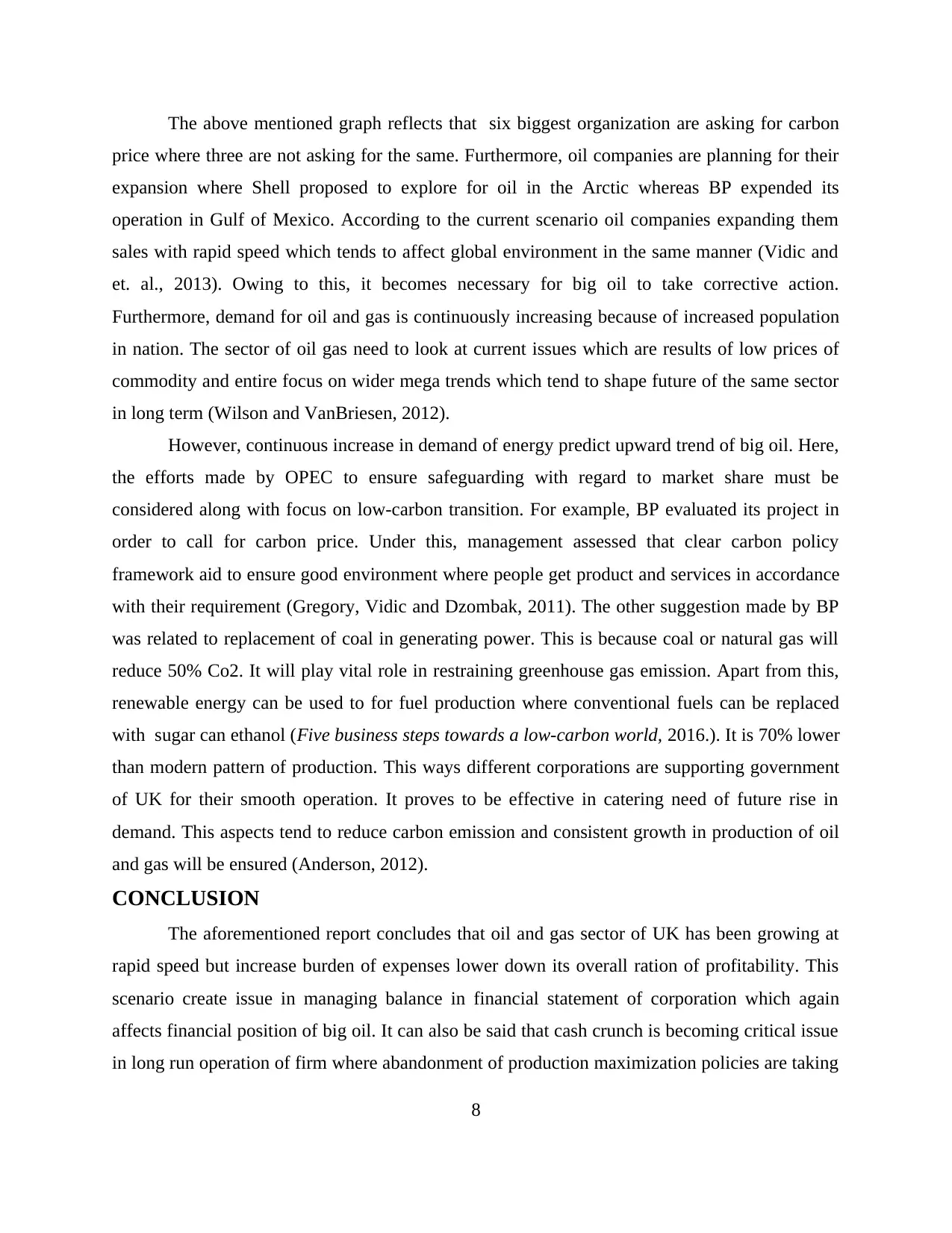
The above mentioned graph reflects that six biggest organization are asking for carbon
price where three are not asking for the same. Furthermore, oil companies are planning for their
expansion where Shell proposed to explore for oil in the Arctic whereas BP expended its
operation in Gulf of Mexico. According to the current scenario oil companies expanding them
sales with rapid speed which tends to affect global environment in the same manner (Vidic and
et. al., 2013). Owing to this, it becomes necessary for big oil to take corrective action.
Furthermore, demand for oil and gas is continuously increasing because of increased population
in nation. The sector of oil gas need to look at current issues which are results of low prices of
commodity and entire focus on wider mega trends which tend to shape future of the same sector
in long term (Wilson and VanBriesen, 2012).
However, continuous increase in demand of energy predict upward trend of big oil. Here,
the efforts made by OPEC to ensure safeguarding with regard to market share must be
considered along with focus on low-carbon transition. For example, BP evaluated its project in
order to call for carbon price. Under this, management assessed that clear carbon policy
framework aid to ensure good environment where people get product and services in accordance
with their requirement (Gregory, Vidic and Dzombak, 2011). The other suggestion made by BP
was related to replacement of coal in generating power. This is because coal or natural gas will
reduce 50% Co2. It will play vital role in restraining greenhouse gas emission. Apart from this,
renewable energy can be used to for fuel production where conventional fuels can be replaced
with sugar can ethanol (Five business steps towards a low-carbon world, 2016.). It is 70% lower
than modern pattern of production. This ways different corporations are supporting government
of UK for their smooth operation. It proves to be effective in catering need of future rise in
demand. This aspects tend to reduce carbon emission and consistent growth in production of oil
and gas will be ensured (Anderson, 2012).
CONCLUSION
The aforementioned report concludes that oil and gas sector of UK has been growing at
rapid speed but increase burden of expenses lower down its overall ration of profitability. This
scenario create issue in managing balance in financial statement of corporation which again
affects financial position of big oil. It can also be said that cash crunch is becoming critical issue
in long run operation of firm where abandonment of production maximization policies are taking
8
price where three are not asking for the same. Furthermore, oil companies are planning for their
expansion where Shell proposed to explore for oil in the Arctic whereas BP expended its
operation in Gulf of Mexico. According to the current scenario oil companies expanding them
sales with rapid speed which tends to affect global environment in the same manner (Vidic and
et. al., 2013). Owing to this, it becomes necessary for big oil to take corrective action.
Furthermore, demand for oil and gas is continuously increasing because of increased population
in nation. The sector of oil gas need to look at current issues which are results of low prices of
commodity and entire focus on wider mega trends which tend to shape future of the same sector
in long term (Wilson and VanBriesen, 2012).
However, continuous increase in demand of energy predict upward trend of big oil. Here,
the efforts made by OPEC to ensure safeguarding with regard to market share must be
considered along with focus on low-carbon transition. For example, BP evaluated its project in
order to call for carbon price. Under this, management assessed that clear carbon policy
framework aid to ensure good environment where people get product and services in accordance
with their requirement (Gregory, Vidic and Dzombak, 2011). The other suggestion made by BP
was related to replacement of coal in generating power. This is because coal or natural gas will
reduce 50% Co2. It will play vital role in restraining greenhouse gas emission. Apart from this,
renewable energy can be used to for fuel production where conventional fuels can be replaced
with sugar can ethanol (Five business steps towards a low-carbon world, 2016.). It is 70% lower
than modern pattern of production. This ways different corporations are supporting government
of UK for their smooth operation. It proves to be effective in catering need of future rise in
demand. This aspects tend to reduce carbon emission and consistent growth in production of oil
and gas will be ensured (Anderson, 2012).
CONCLUSION
The aforementioned report concludes that oil and gas sector of UK has been growing at
rapid speed but increase burden of expenses lower down its overall ration of profitability. This
scenario create issue in managing balance in financial statement of corporation which again
affects financial position of big oil. It can also be said that cash crunch is becoming critical issue
in long run operation of firm where abandonment of production maximization policies are taking
8

place. Furthermore, oil companies are asking for low carbon global world through which
consistent operation can be ensured by giving return for damages caused to environment. Apart
from this, strategies are implemented by government of UK in order to reduce cost of production
and maximize recovery.
9
consistent operation can be ensured by giving return for damages caused to environment. Apart
from this, strategies are implemented by government of UK in order to reduce cost of production
and maximize recovery.
9
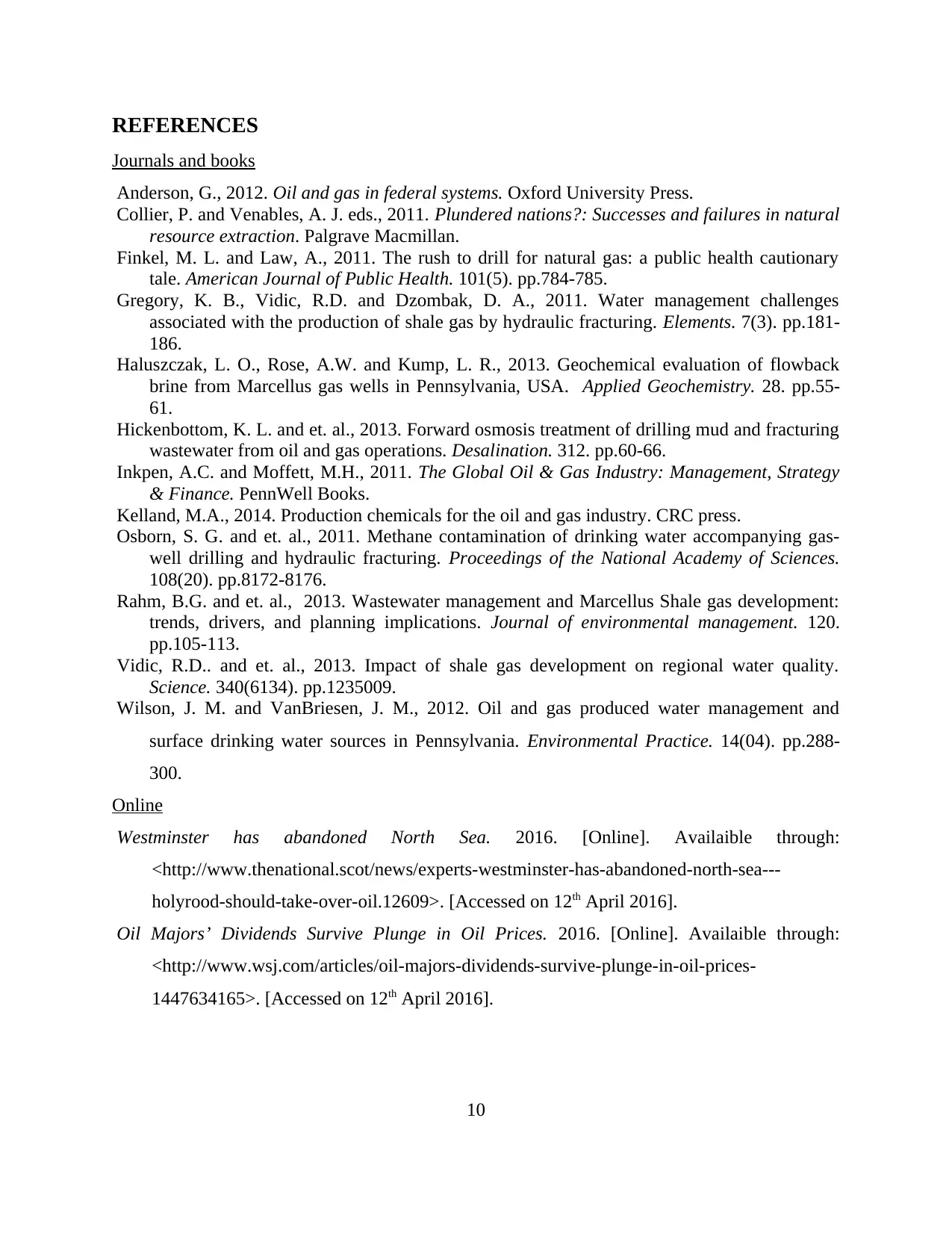
REFERENCES
Journals and books
Anderson, G., 2012. Oil and gas in federal systems. Oxford University Press.
Collier, P. and Venables, A. J. eds., 2011. Plundered nations?: Successes and failures in natural
resource extraction. Palgrave Macmillan.
Finkel, M. L. and Law, A., 2011. The rush to drill for natural gas: a public health cautionary
tale. American Journal of Public Health. 101(5). pp.784-785.
Gregory, K. B., Vidic, R.D. and Dzombak, D. A., 2011. Water management challenges
associated with the production of shale gas by hydraulic fracturing. Elements. 7(3). pp.181-
186.
Haluszczak, L. O., Rose, A.W. and Kump, L. R., 2013. Geochemical evaluation of flowback
brine from Marcellus gas wells in Pennsylvania, USA. Applied Geochemistry. 28. pp.55-
61.
Hickenbottom, K. L. and et. al., 2013. Forward osmosis treatment of drilling mud and fracturing
wastewater from oil and gas operations. Desalination. 312. pp.60-66.
Inkpen, A.C. and Moffett, M.H., 2011. The Global Oil & Gas Industry: Management, Strategy
& Finance. PennWell Books.
Kelland, M.A., 2014. Production chemicals for the oil and gas industry. CRC press.
Osborn, S. G. and et. al., 2011. Methane contamination of drinking water accompanying gas-
well drilling and hydraulic fracturing. Proceedings of the National Academy of Sciences.
108(20). pp.8172-8176.
Rahm, B.G. and et. al., 2013. Wastewater management and Marcellus Shale gas development:
trends, drivers, and planning implications. Journal of environmental management. 120.
pp.105-113.
Vidic, R.D.. and et. al., 2013. Impact of shale gas development on regional water quality.
Science. 340(6134). pp.1235009.
Wilson, J. M. and VanBriesen, J. M., 2012. Oil and gas produced water management and
surface drinking water sources in Pennsylvania. Environmental Practice. 14(04). pp.288-
300.
Online
Westminster has abandoned North Sea. 2016. [Online]. Availaible through:
<http://www.thenational.scot/news/experts-westminster-has-abandoned-north-sea---
holyrood-should-take-over-oil.12609>. [Accessed on 12th April 2016].
Oil Majors’ Dividends Survive Plunge in Oil Prices. 2016. [Online]. Availaible through:
<http://www.wsj.com/articles/oil-majors-dividends-survive-plunge-in-oil-prices-
1447634165>. [Accessed on 12th April 2016].
10
Journals and books
Anderson, G., 2012. Oil and gas in federal systems. Oxford University Press.
Collier, P. and Venables, A. J. eds., 2011. Plundered nations?: Successes and failures in natural
resource extraction. Palgrave Macmillan.
Finkel, M. L. and Law, A., 2011. The rush to drill for natural gas: a public health cautionary
tale. American Journal of Public Health. 101(5). pp.784-785.
Gregory, K. B., Vidic, R.D. and Dzombak, D. A., 2011. Water management challenges
associated with the production of shale gas by hydraulic fracturing. Elements. 7(3). pp.181-
186.
Haluszczak, L. O., Rose, A.W. and Kump, L. R., 2013. Geochemical evaluation of flowback
brine from Marcellus gas wells in Pennsylvania, USA. Applied Geochemistry. 28. pp.55-
61.
Hickenbottom, K. L. and et. al., 2013. Forward osmosis treatment of drilling mud and fracturing
wastewater from oil and gas operations. Desalination. 312. pp.60-66.
Inkpen, A.C. and Moffett, M.H., 2011. The Global Oil & Gas Industry: Management, Strategy
& Finance. PennWell Books.
Kelland, M.A., 2014. Production chemicals for the oil and gas industry. CRC press.
Osborn, S. G. and et. al., 2011. Methane contamination of drinking water accompanying gas-
well drilling and hydraulic fracturing. Proceedings of the National Academy of Sciences.
108(20). pp.8172-8176.
Rahm, B.G. and et. al., 2013. Wastewater management and Marcellus Shale gas development:
trends, drivers, and planning implications. Journal of environmental management. 120.
pp.105-113.
Vidic, R.D.. and et. al., 2013. Impact of shale gas development on regional water quality.
Science. 340(6134). pp.1235009.
Wilson, J. M. and VanBriesen, J. M., 2012. Oil and gas produced water management and
surface drinking water sources in Pennsylvania. Environmental Practice. 14(04). pp.288-
300.
Online
Westminster has abandoned North Sea. 2016. [Online]. Availaible through:
<http://www.thenational.scot/news/experts-westminster-has-abandoned-north-sea---
holyrood-should-take-over-oil.12609>. [Accessed on 12th April 2016].
Oil Majors’ Dividends Survive Plunge in Oil Prices. 2016. [Online]. Availaible through:
<http://www.wsj.com/articles/oil-majors-dividends-survive-plunge-in-oil-prices-
1447634165>. [Accessed on 12th April 2016].
10
Secure Best Marks with AI Grader
Need help grading? Try our AI Grader for instant feedback on your assignments.

Cash Crunch Clouds Future for Oil Firms. 2016. [Online]. Availaible through:
<http://www.wsj.com/articles/cash-crunch-clouds-future-for-oil-firms-1445816429>.
[Accessed on 12th April 2016].
Five business steps towards a low-carbon world. 2016. [Online]. Availaible through:
<http://www.bp.com/en/global/corporate/bp-magazine/observations/climate-change-
challenge.html>. [Accessed on 12th April 2016].
11
<http://www.wsj.com/articles/cash-crunch-clouds-future-for-oil-firms-1445816429>.
[Accessed on 12th April 2016].
Five business steps towards a low-carbon world. 2016. [Online]. Availaible through:
<http://www.bp.com/en/global/corporate/bp-magazine/observations/climate-change-
challenge.html>. [Accessed on 12th April 2016].
11
1 out of 11
Related Documents
Your All-in-One AI-Powered Toolkit for Academic Success.
+13062052269
info@desklib.com
Available 24*7 on WhatsApp / Email
![[object Object]](/_next/static/media/star-bottom.7253800d.svg)
Unlock your academic potential
© 2024 | Zucol Services PVT LTD | All rights reserved.




